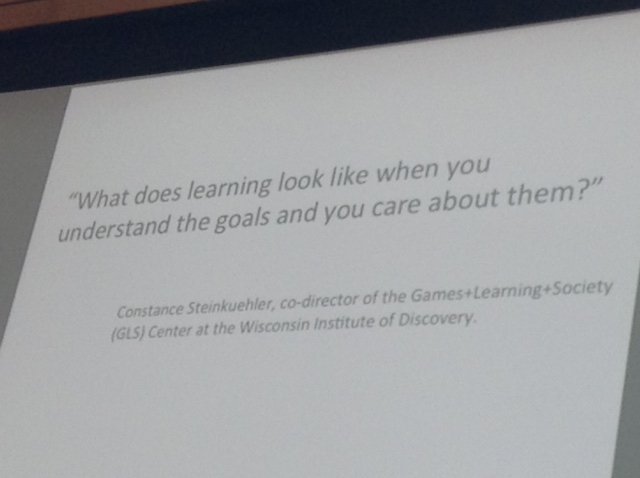Searching for "student evaluation"
#MNsummit2015
Main speaker
Aaron Doering
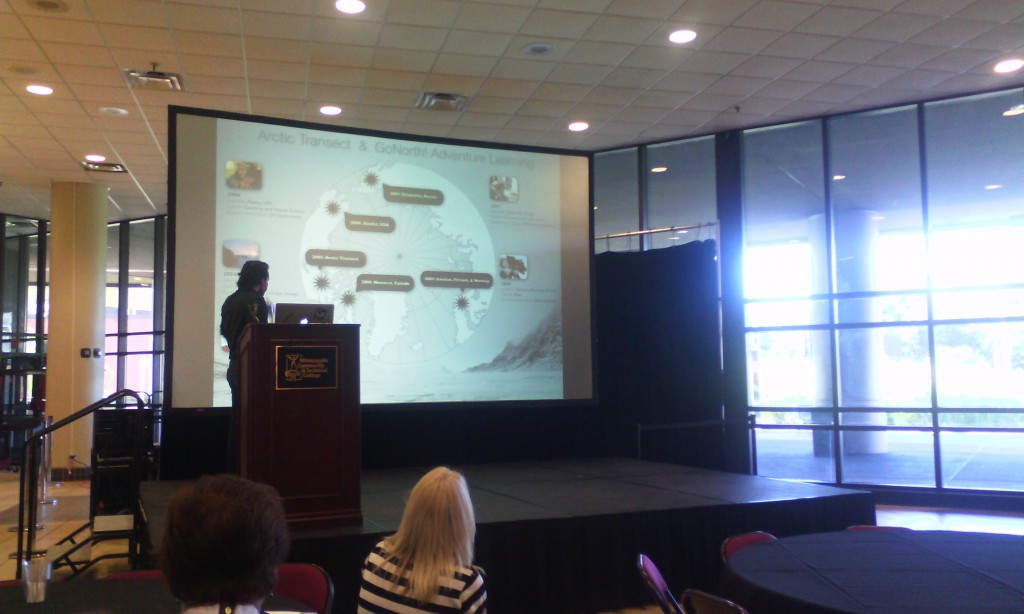
aaron doening
Engagement not completion
Design experience not product
Create change, not simply respond to it
He was a geography teacher : Dimitrina
Experience explore expand. Adventure based how to collaborate in ways we have not collaborated before pedagogical guidelines internet driven
Instructor – content – design
Today: first think is design, content, instructor. So how do we design learning environments is the most important one
Guide learners as designers. Constructivism. Design for meaning. Through the power of the story.
Geotetic design a learning environment learn geography using GIS
Situated movies (student-centered learning)
Grant Earthducation go to the most remote parts of the world to align their education with their culture, instead of what the government is downing as culture
Use of phone: whoever answers instructor’s question first, gets to pose the next question to the rest of the audience.
Design based research
Self-narrative, referencing the experience real world issues in real time
- reference knowledge . knowledge overlap. Technological pedagogical content knowledge.
Geotetic not only how prepare teachers, but desing learning environmwer of the story.
we explore: https://www.we-explore.com/
9.5 design as a learner.
the U Media Lab.
The Changing Earth. App GoX (instagram on steroids. tell their story through the app). How is this different from Google Earth
Raptor Lab (rehabilitate a raptor).
- design experiences
- build trust
- guide learners as designers
- recognize learners as experts
- encourage collaboration
- inspire self narrative
- reference the knowledge domains
- teach for change
- design as learner
adoering@umn.edi chasingseals.com @chasingseals
podcast pontification (audio version of blog self reflections)
Greg Steinke The U
A Digital Story Assignment using WeVideo

WeVideo is the Google response to iMovie cloud
The U is on Google email and thus google drive and all other google tools
The Center for Digital Storytelling. short videos, 3-5 min incorporate photographs with the author narration, reflection
Assignment (verbal directions). process (write a 2 page script, every page is about a minute of video), gather images that support the story; edit the script (rewrite); record audio to the script (use an app on the phone instead of WeVideo), WeVideo can edit the audio recording; edit the story, edit the photos to match the story; YourTube and/or Google+
working with faculty: is the digital story a good fit for your course? two questions: does the course have many writing assignments? does everyone have to do the same type of assignment? do you want to offer choices? do you want your students to share their work outside of the class? to you want to explore opportunities for students to develop 21 century skills?
google communities for sharing
wewideo has a tutorial at Center for Digital Storytelling
students can use the digital story for their eportfolio
the entire exercise is entirely based on mobile devices
time frame: scaffolding options
3d printing products were the tangible result of the project and the digital storytelling just the format to present
Google Drive master folder for the phone images and video; iOS apps: MoviePro, FiLMc Pro, VoiceRecord Pro (including mp3); Android: WeVideo
Storyboard template
Faculty Development Programs: Digital Storytelling Community of Practice
http://it.umn.edu/faculty-development-programs-digital-0
Poster sessions:
Brad Hokanson
http://dha.design.umn.edu/faculty/BHokanson.html
iPAD video kit:

Laurie Conzemius
Critical Thinking

ISTE: http://conference.iste.org/2016/
Joe Lau critical thinking
apps: Popplet blog.popplet.com http://www.popplet.com/ (mindmapping)
into the book: http://reading.ecb.org/
Kahoot – the token system. Polleverywhere https://blog.stcloudstate.edu/ims/2015/05/21/polls-and-surveys-tools-for-education/
Symbaloo https://www.symbaloo.com/home/mix/13eOcK1fiV zotero, easybib, delicious, diigo depending on the grade
youth voices; http://youthvoices.net/ replace social media like teachertube is trying to replace youtube
quandary games in education. https://www.quandarygame.org/ sim city
citizen science alliance http://www.citizensciencealliance.org/
Toontastic https://itunes.apple.com/us/app/toontastic/id404693282?mt=8 now free storytelling
coding and programming: https://www.makewonder.com/robots/dashanddot scratch
Osmo : https://www.playosmo.com/en/ $79.99 + give a set for free Stride principle as a parental involvement
chainlink;
kickword; https://play.google.com/store/apps/details?id=com.makario.wordkick
red herring (four categories) https://play.google.com/store/apps/details?id=com.BlueOxTech.RedHerring&hl=en
http://www.mathplayground.com/logicgames.html
http://www.mathplayground.com/thinkingblocks.html
evaluation:
telestory https://itunes.apple.com/us/app/telestory/id915378506?mt=8
explain everything http://explaineverything.com/
Exploring and Connecting 3D Printing to Teaching and Learning Jason Spartz, Saint Mary’s University of Minnesota
http://pubs.lib.umn.edu/minnesota-elearning-summit/2015/program/23/
http://pubs.lib.umn.edu/cgi/viewcontent.cgi?article=1023&context=minnesota-elearning-summit
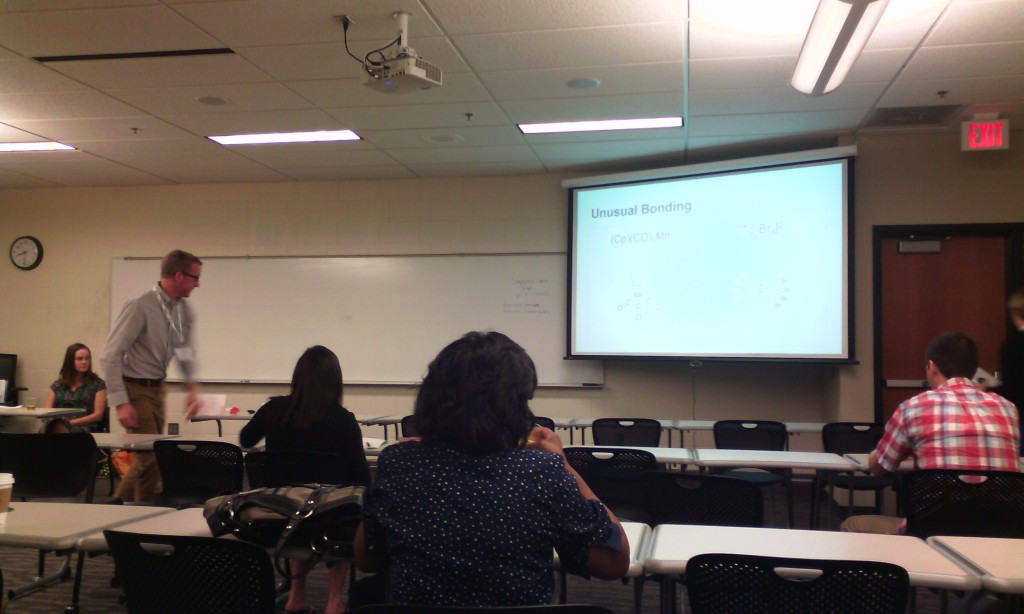
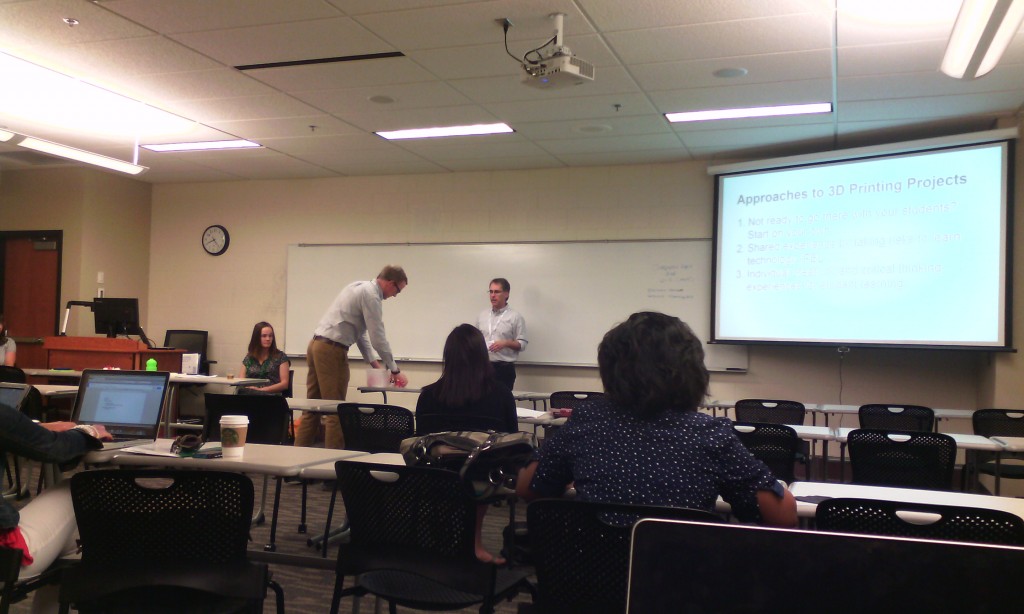
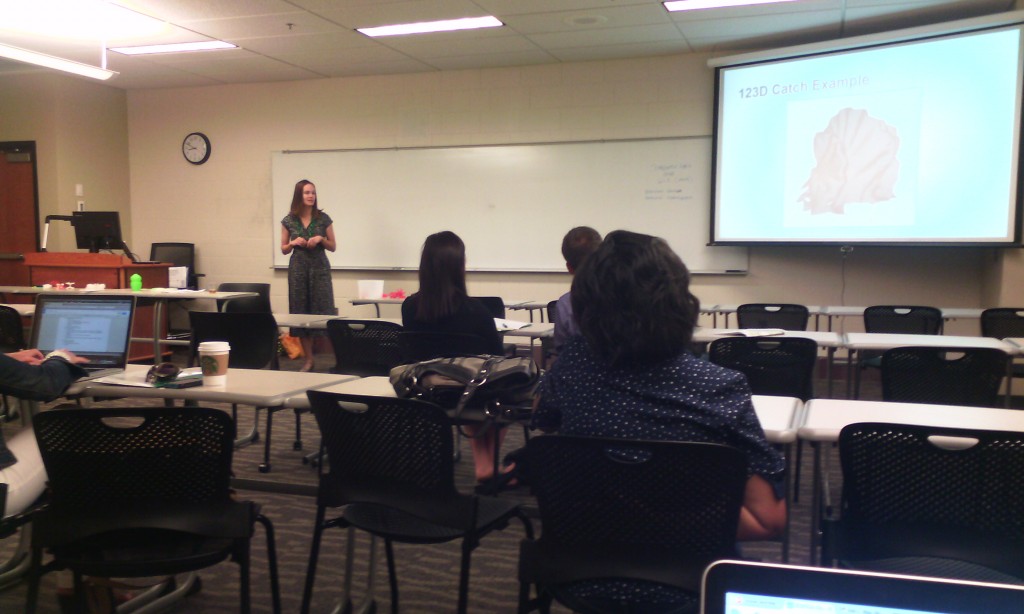
Jason Spartz, Saint Mary’s University of MinnesotaFollow
Lisa Truax, Saint Mary’s University of MinnesotaFollow
Karen Sorvaag, Saint Mary’s University of MinnesotaFollow
Brett Bodsgard, Saint Mary’s University of MinnesotaFollow
chemistry professor. 3D printing with different materials.
what else can be made (e.g. reaction vessel)
printing of atoms
crystalography dbase
Karen: pre-service teachers professor: how to use 3d printers and be comfortable with them. Steve Hoover. Thinkercad and Autodesk123D>
3D academy http://www.team3dacademy.com/index2.html. Pinterest board for3d Printing with resources
Lisa: graphic design. not intuitive. Rhinoceros (not free anymore). 123D strong learning curve. 3d printing will be incorporated in the curriculum. sculpture students and others don’t like fudging on the computer, but Adobe people love it. Some items takes up to 4 hours to print out. when working on the computer is difficult for some students to visualize the dimensionality.
collaborative learning opportunities.
no makerspace or fab lab. additional interest from the theater and business dept. 3d printing is connected to future work skills. new media ecology or media literacy set of skills.
the main presenter: build excitement and interest and gradually step back. how much material goes through and should we charge back. clean and maintenance involved; not too bad. better then a copier. plastic inexpensive. sizes with plastic – $25 and $50. how many project of a spool: depending on the size of the projects but considerable amount. two printers one art dept and one in the faculty dev area.
non profit visually impaired students. how 3d can make difference in special ed.
3d printing lab with access for everybody. ownership brings policy. where housed: neutral place.
only one printer is barely sufficient for faculty to figure out how to use it. purchasing two more if students and curricula to be involved.
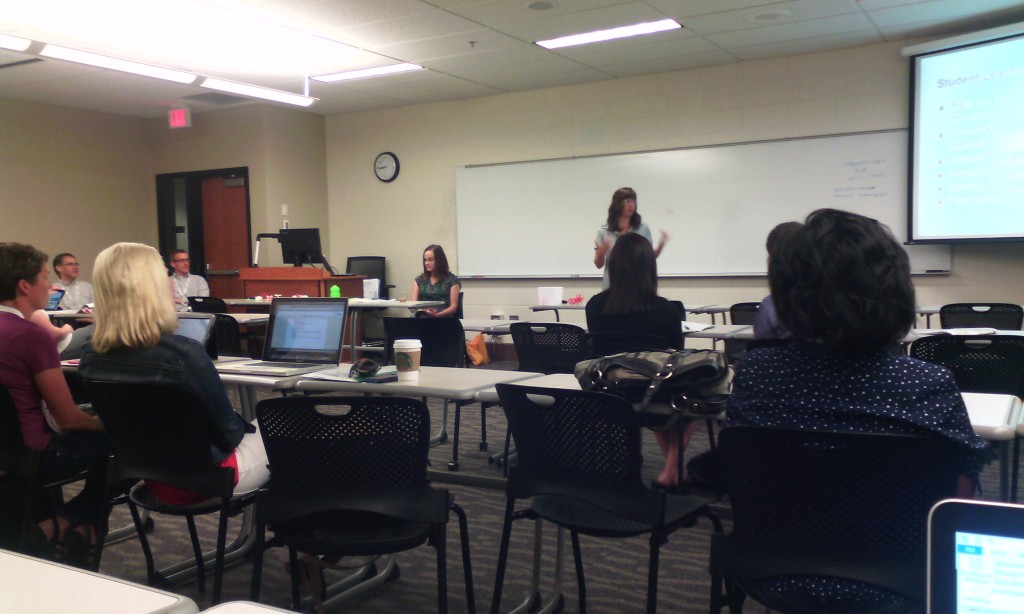



The Balancing Act: Team-Creating an eBook as an Alternative Method for Content Delivery Tom Nechodomu, University of Minnesota

Faculty Created digital stories – google “cultivaitng change series”
student created digital stories –
Susan Andre uses a slide titled “trust” to elucidate how the entire project was enabled. “trust” and “transparency” are sparse currency in the environment I work in. if she is right an ebook ain’t happening anytime soon at my place.
inclining habitat.
students involvement. use stipends. student artists. food for the video interviews. create a community, student centered.
people able to change the book.
copyright process; did you find it cumbersome. copyright permission center.
time span and amount of hours spent: 3-4 months per chapter.
Main speaker
David Wiley. Making Teaching and Learning Awesome with Open
MN Learning Commons
open educational resources
LUMEN
education – sharing feedback, encouragement with students passion about the discipline, yourself
open is not the same as free. free + permissions + copyright permission: 5 r = retain (make and own copies), reuse (use in a wide range of ways), revise (adapt, modify, and improve), remix (combine two or more), redistribute (share with others)
open:
free and unfettered access
perpetual, irrevocable copyright permissions
(look but don’t touch is not open)
tech enables OER permits
traditionally copyright materials on the Internet – not so good ; jet on the road
openly copyright materials on the internet _ yes: jet in the air
permission-less innovation. relatively inexpensive and broad permissions.
intellectual infrastructure of education: learning outcomes/objectives; assessments; textbooks. they are relatively expensive and narrow permissions.
disappearing ink strategies: buyback, rental, ebooks, online subscription
mad, glad, sad, rad: the grumpy cat. student success per dollar
opennetgroup.org/review
change in student learning: replace commercial with open books – small. realign, bigger change. rethink is the large change.
responsibilities:
attribution and meeting other license requirements
thin common cartridge: a way to bring the content to the CMS, but the content remains on the creative commons
disposable assignment: students hate doing them, instructors hate grading them. waste of time and energy
so what?
open education infrastructure: open outcomes, objectives, activities, educational resources
the culture of glued legos must be eradicated. open pedagogy. open credentialing model
summary: don’t settle for “affordable.” improve student outcomes. improve affordability. improve design / academic freedom
links generated from the discussion at my presentation:
Routledge. (n.d.). Handbook of Mobile Learning (Hardback) – Routledge [Text]. Retrieved May 27, 2015, from
http://www.routledge.com/books/details/9780415503693/
Crompton, Muilenburg and Berge’s definition for m-learning is “learning across multiple contexts, through social and content interactions, using personal electronic devices.”
The “context”in this definition encompasses m-learnng that is formalself-directed, and spontaneous learning, as well as learning that is context aware and context neutral.
therefore, m-learning can occur inside or outside the classroom, participating in a formal lesson on a mobile device; it can be self-directed, as a person determines his or her own approach to satisfy a learning goal; or spontaneous learning, as a person can use the devices to look up something that has just prompted an interest (Crompton, 2013, p. 83). (Gaming article Tallinn)Constructivist Learnings in the 1980s – Following Piage’s (1929), Brunner’s (1996) and Jonassen’s (1999) educational philosophies, constructivists proffer that knowledge acquisition develops through interactions with the environment. (p. 85). The computer was no longer a conduit for the presentation of information: it was a tool for the active manipulation of that information” (Naismith, Lonsdale, Vavoula, & Sharples, 2004, p. 12)Constructionist Learning in the 1980s – Constructionism differed from constructivism as Papert (1980) posited an additional component to constructivism: students learned best when they were actively involved in constructing social objects. The tutee position. Teaching the computer to perform tasks.Problem-Based learning in the 1990s – In the PBL, students often worked in small groups of five or six to pool knowledge and resources to solve problems. Launched the sociocultural revolution, focusing on learning in out of school contexts and the acquisition of knowledge through social interaction
Socio-Constructivist Learning in the 1990s. SCL believe that social and individual processes are independent in the co-construction of knowledge (Sullivan-Palinscar, 1998; Vygotsky, 1978).
96-97). Keegan (2002) believed that e-learning was distance learning, which has been converted to e-learning through the use of technologies such as the WWW. Which electronic media and tools constituted e-learning: e.g., did it matter if the learning took place through a networked technology, or was it simply learning with an electronic device?
99-100. Traxler (2011) described five ways in which m-learning offers new learning opportunities: 1. Contingent learning, allowing learners to respond and react to the environment and changing experiences; 2. Situated learning, in which learning takes place in the surroundings applicable to the learning; 3. Authentic learning;
Diel, W. (2013). M-Learning as a subfield of open and distance education. In: Berge and Muilenburg (Eds.). Handbook of Mobile Learning.
- 15) Historical context in relation to the field of distance education (embedded librarian)
- 16 definition of independent study (workshop on mlearning and distance education
- 17. Theory of transactional distance (Moore)
Cochrane, T. (2013). A Summary and Critique of M-Learning Research and Practice. In: Berge and Muilenburg (Eds.). Handbook of Mobile Learning.
( Galin class, workshop)
P 24
According to Cook and Sharples (2010) the development of M learning research has been characterized by three general faces a focus upon Devices Focus on learning outside the classroom He focus on the mobility of the learner
- 25
Baby I am learning studies focus upon content delivery for small screen devices and the PDA capabilities of mobile devices rather than leveraging the potential of mobile devices for collaborative learning as recommended by hope Joyner Mill Road and sharp P. 26 Large scale am learning project Several larger am learning projects have tended to focus on specific groups of learners rather than developing pedagogical strategies for the integration of am mlearning with him tertiary education in general
27
m learning research funding
In comparison am learning research projects in countries with smaller population sizes such as Australia and New Zealand are typiclly funded on a shoe string budget
28
M-learning research methodologies
I am learning research has been predominantly characterized by short term case studies focused upon The implementation of rapidly changing technologies with early adopters but with little evaluation reflection or emphasis on mainstream tertiary-education integration
p. 29 identifying the gaps in M learning research
lack of explicit underlying pedagogical theory Lack of transferable design frameworks
Cochrane, T. (2011).Proceedings ascilite 2011 Hobart:Full Paper 250 mLearning: Why? What? Where? How? http://www.ascilite.org/conferences/hobart11/downloads/papers/Cochrane-full.pdf
(Exploring mobile learning success factors http://files.eric.ed.gov/fulltext/EJ893351.pdf
https://prezi.com/kr94rajmvk9u/mlearning/
https://thomcochrane.wikispaces.com/MLearning+Praxis
Pachler, N., Bachmair, B., and Cook, J. (2013). A Sociocultural Ecological Frame for Mobile Learning. In: Berge and Muilenburg (Eds.). Handbook of Mobile Learning.
(Tom video studio)
35 a line of argumentation that defines mobile devices such as mobile phones as cultural resources. Mobile cultural resources emerge within what we call a “bile complex‘, which consist of specifics structures, agency and cultural practices.
36 pedagogy looks for learning in the context of identify formation of learners within a wider societal context However at the beginning of the twentieth first century and economy oriented service function of learning driven by targets and international comparisons has started to occupy education systems and schools within them Dunning 2000 describes the lengthy transformation process from natural assets Land unskilled labor to tangible assets machinery to intangible created assets such as knowledge and information of all kinds Araya and Peters 2010 describe the development of the last 20 years in terms of faces from the post industrial economy to d information economy to the digital economy to the knowledge economy to the creative economy Cultural ecology can refer to the debate about natural resources we argue for a critical debate about the new cultural resources namely mobile devices and the services for us the focus must not be on the exploitation of mobile devices and services for learning but instead on the assimilation of learning with mobiles in informal contacts of everyday life into formal education
37
Ecology comes into being is there exists a reciprocity between perceiver and environment translated to M learning processes this means that there is a reciprocity between the mobile devices in the activity context of everyday life and the formal learning
45
Rather than focusing on the acquisition of knowledge in relation to externally defined notions of relevance increasingly in a market-oriented system individual faces the challenge of shape his/her knowledge out of his/her own sense of his/her world information is material which is selected by individuals to be transformed by them into knowledge to solve a problem in the life world
Crompton, H. (2013). A Sociocultural Ecological Frame for Mobile Learning. In: Berge and Muilenburg (Eds.). Handbook of Mobile Learning.
p. 47 As philosophies and practice move toward learner-centered pedagogies, technology in a parallel move, is now able to provide new affordances to the learner, such as learning that is personalized, contextualized, and unrestricted by temporal and spatial constrains.
The necessity for m-learning to have a theory of its own, describing exactly what makes m-learning unique from conventional, tethered electronic learning and traditional learning.
48 . Definition and devices. Four central constructs. Learning pedagogies, technological devices, context and social interactions.
“learning across multiple contexts, through social and content interactions, using personal electronic devices.”
It is difficult, and ill advisable, to determine specifically which devices should be included in a definition of m-learning, as technologies are constantly being invented or redesigned. (my note against the notion that since D2L is a MnSCU mandated tool, it must be the one and only). One should consider m-learning as the utilization of electronic devices that are easily transported and used anytime and anywhere.
49 e-learning does not have to be networked learning: therefore, e-learnng activities could be used in the classroom setting, as the often are.
Why m-learning needs a different theory beyond e-learning. Conventional e-learning is tethered, in that students are anchored to one place while learning. What sets m-learning apart from conventional e-learning is the very lack of those special and temporal constrains; learning has portability, ubiquitous access and social connectivity.
50 dominant terms for m-learning should include spontaneous, intimate, situated, connected, informal, and personal, whereas conventional e-learning should include the terms computer, multimedia, interactive, hyperlinked, and media-rich environment.
51 Criteria for M-Learning
second consideration is that one must be cognizant of the substantial amount of learning taking place beyond the academic and workplace setting.
52 proposed theories
Activity theory: Vygotsky and Engestroem
Conversation theory: Pask 1975, cybernetic and dialectic framework for how knowledge is constructed. Laurillard (2007) although conversation is common for all forms of learning, m-learning can build in more opportunities for students to have ownership and control over what they are learning through digitally facilitated, location-specific activities.
53 multiple theories;
54 Context is central construct of mobile learning. Traxler (2011) described the role of context in m-learning as “context in the wider context”, as the notion of context becomes progressively richer. This theme fits with Nasimith et al situated theory, which describes the m-learning activities promoting authentic context and culture.
55. Connectivity
unlike e-learning, the learner is not anchored to a set place. it links to Vygotsky’s sociocultural approach.
Learning happens within various social groups and locations, providing a diverse range of connected learning experiences. furthermore, connectivity is without temporal restraints, such as the schedules of educators.
55. Time
m-larning as “learning dispersed in time”
55. personalization
my note student-centered learning
Moura, A., Carvalho, A. (2013). Framework For Mobile Learning Integration Into Educational Contexts. In: Berge and Muilenburg (Eds.). Handbook of Mobile Learning.
p. 58 framework is based on constructivist approach, Activity theory, and the attention, relevance and confidence satisfaction (ARCS) model http://www.arcsmodel.com/#!
http://torreytrust.com/images/ITH_Trust.pdf
to set a didacticmodel that can be applied to m-learning requires looking at the characteristics of specific devi
https://www.researchgate.net/profile/Nadire_Cavus/publication/235912545_Basic_elements_and_characteristics_of_mobile_learning/links/02e7e526c1c0647142000000.pdf
https://eleed.campussource.de/archive/9/3704
Tumbleson, B. E., & Burke, J. (. J. (2013). Embedding librarianship in learning management systems: A how-to-do-it manual for librarians. Neal-Schuman, an imprint of the American Library Association.
|
 |
https://scsu.mplus.mnpals.net/vufind/Record/007650037
see also:
Kvenild, C., & Calkins, K. (2011).
Embedded Librarians: Moving Beyond One-Shot Instruction – Books / Professional Development – Books for Academic Librarians – ALA Store. ACRL. Retrieved from
http://www.alastore.ala.org/detail.aspx?ID=3413
p. 20 Embedding Academic and Research Libraries in the Curriculum: 2014-nmc-horizon-report-library-EN
xi. the authors are convinced that LMS embedded librarianship is becoming he primary and most productive method for connecting with college and university students, who are increasingly mobile.
xii. reference librarians engage the individual, listen, discover what is wanted and seek to point the stakeholder in profitable directions.
Instruction librarians, in contrast, step into the classroom and attempt to lead a group of students in new ways of searching wanted information.
Sometimes that instruction librarian even designs curriculum and teaches their own credit course to guide information seekers in the ways of finding, evaluating, and using information published in various formats.
Librarians also work in systems, emerging technologies, and digital initiatives in order to provide infrastructure or improve access to collections and services for tend users through the library website, discovery layers, etc. Although these arenas seemingly differ, librarians work as one.
xiii. working as an LMS embedded librarian is both a proactive approach to library instruction using available technologies and enabling a 24/7 presence.
1. Embeddedness involves more that just gaining perspective. It also allows the outsider to become part of the group through shared learning experiences and goals. 3. Embedded librarianship in the LMS is all about being as close as possible to where students are receiving their assignments and gaining instruction and advice from faculty members. p. 6 When embedded librarians provide ready access to scholarly electronic collections, research databases, and Web 2.0 tools and tutorials, the research experience becomes less frustrating and more focused for students. Undergraduate associate this familiar online environment with the academic world.
p. 7 describes embedding a reference librarian, which LRS reference librarians do, “partnership with the professor.” However, there is room for “Research Consultations” (p. 8). While “One-Shot Library Instruction Sessions” and “Information Literacy Credit Courses” are addressed (p. 809), the content of these sessions remains in the old-fashioned lecturing type of delivering the information.
p. 10-11. The manuscript points out clearly the weaknesses of using a Library Web site. The authors fail to see that the efforts of the academic librarians must go beyond Web page and seek how to easy the information access by integrating the power of social media with the static information residing on the library web page.
p. 12 what becomes disturbingly clear is that faculty focus on the mechanics of the research paper over the research process. Although students are using libraries, 70 % avoid librarians. Urging academic librarians to “take an active role and initiate the dialogue with faculty to close a divide that may be growing between them and faculty and between them and students.”
Four research context with which undergraduates struggle: big picture, language, situational context and information gathering.
p. 15 ACRL standards One and Three: librarians might engage students who rely on their smartphones, while keeping in mind that “[s]tudents who retrieve information on their smartphones may also have trouble understanding or evaluating how the information on their phone is ‘produced, organized, and disseminated’ (Standard One).
Standard One by its definition seems obsolete. If information is formatted for desktops, it will be confusing when on smart phones, And by that, it is not mean to adjust the screen size, but change the information delivery from old fashioned lecturing to more constructivist forms. e.g. http://web.stcloudstate.edu/pmiltenoff/bi/
p. 15 As for Standard Two, which deals with effective search strategies, the LMS embedded librarian must go beyond Boolean operators and controlled vocabulary, since emerging technologies incorporate new means of searching. As unsuccessfully explained to me for about two years now at LRS: hashtag search, LinkedIn groups etc, QR codes, voice recognition etc.
p. 16. Standard Five. ethical and legal use of information.
p. 23 Person announced in 2011 OpenClass compete with BB, Moodle, Angel, D2L, WebCT, Sakai and other
p. 24 Common Features: content, email, discussion board, , synchronous chat and conferencing tools (Wimba and Elluminate for BB)
p. 31 information and resources which librarians could share via LMS
– post links to dbases and other resources within the course. LIB web site, LibGuides or other subject-related course guidelines
– information on research concepts can be placed in a similar fashion. brief explanation of key information literacy topics (e.g difference between scholarly and popular periodical articles, choosing or narrowing research topics, avoiding plagiarism, citing sources properly whining required citations style, understanding the merits of different types of sources (Articles book’s website etc)
– Pertinent advice the students on approaching the assignment and got to rheank needed information
– Tutorials on using databases or planning searches step-by-step screencast navigating in search and Candida bass video search of the library did you a tour of the library
p. 33 embedded librarian being copied on the blanked emails from instructor to students.
librarian monitors the discussion board
p. 35 examples: students place specific questions on the discussion board and are assured librarian to reply by a certain time
instead of F2F instruction, created a D2L module, which can be placed in any course. videos, docls, links to dbases, links to citation tools etc. Quiz, which faculty can use to asses the the students
p. 36 discussion forum just for the embedded librarian. for the students, but faculty are encouraged to monitor it and provide content- or assignment-specific input
video tutorials and searching tips
Contact information email phone active IM chat information on the library’s open hours
p. 37 questions to consider
what is the status of the embedded librarian: T2, grad assistant
p. 41 pilot program. small scale trial which is run to discover and correct potential problems before
One or two faculty members, with faculty from a single department
Pilot at Valdosta State U = a drop-in informatil session with the hope of serving the information literacy needs of distance and online students, whereas at George Washington U, librarian contacted a distance education faculty member to request embedding in his upcoming online Mater’s course
p. 43 when librarians sense that current public services are not being fully utilized, it may signal that a new approach is needed.
pilots permit tinkering. they are all about risk-taking to enhance delivery
p. 57 markeing LMS ebedded Librarianship
library collections, services and facilities because faculty may be uncertain how the service benefits their classroom teaching and learning outcomes.
my note per
“it is incumbent upon librarians to promote this new mode of information literacy instruction.” it is so passe. in the times when digital humanities is discussed and faculty across campus delves into digital humanities, which de facto absorbs digital literacy, it is shortsighted for academic librarians to still limit themselves into “information literacy,” considering that lip service is paid for for librarians being the leaders in the digital humanities movement. If academic librarians want to market themselves, they have to think broad and start with topics, which ARE of interest for the campus faculty (digital humanities included) and then “push” their agenda (information literacy). One of the reasons why academic libraries are sinking into oblivion is because they are sunk already in 1990-ish practices (information literacy) and miss the “hip” trends, which are of interest for faculty and students. The authors (also paying lip services to the 21st century necessities), remain imprisoned to archaic content. In the times, when multi (meta) literacies are discussed as the goal for library instruction, they push for more arduous marketing of limited content. Indeed, marketing is needed, but the best marketing is by delivering modern and user-sought content.
the stigma of “academic librarians keep doing what they know well, just do it better.” Lip-services to change, and life-long learning. But the truth is that the commitment to “information literacy” versus the necessity to provide multi (meta) literacites instruction (Reframing Information Literacy as a metaliteracy) is minimizing the entire idea of academic librarians reninventing themselves in the 21st century.
Here is more: NRNT-New Roles for New Times
p. 58 According to the Burke and Tumbleson national LMS embedded librarianship survey, 280 participants yielded the following data regarding embedded librarianship:
- traditional F2F LMS courses – 69%
- online courses – 70%
- hybrid courses – 54%
- undergraduate LMS courses 61%
- graduate LMS courses 42%
of those respondents in 2011, 18% had the imitative started for four or more years, which place the program in 2007. Thus, SCSU is almost a decade behind.
p. 58 promotional methods:
- word of mouth
- personal invitation by librarians
- email by librarians
- library brochures
- library blogs
four years later, the LRS reference librarians’ report https://magic.piktochart.com/output/5704744-libsmart-stats-1415 has no mentioning of online courses, less to say embedded librarianship
my note:
library blog was offered numerous times to the LRS librarians and, consequently to the LRS dean, but it was brushed away, as were brushed away the proposals for modern institutional social media approach (social media at LRS does not favor proficiency in social media but rather sees social media as learning ground for novices, as per 11:45 AM visit to LRS social media meeting of May 6, 2015). The idea of the blog advantages to static HTML page was explained in length, but it was visible that the advantages are not understood, as it is not understood the difference of Web 2.0 tools (such as social media) and Web 1.0 tools (such as static web page). The consensus among LRS staff and faculty is to keep projecting Web 1.0 ideas on Web 2.0 tools (e.g. using Facebook as a replacement of Adobe Dreamweaver: instead of learning how to create static HTML pages to broadcast static information, use Facebook for fast and dirty announcement of static information). It is flabbergasting to be rejected offering a blog to replace Web 1.0 in times when the corporate world promotes live-streaming (http://www.socialmediaexaminer.com/live-streaming-video-for-business/) as a way to promote services (academic librarians can deliver live their content)
p. 59 Marketing 2.0 in the information age is consumer-oriented. Marketing 3.0 in the values-driven era, which touches the human spirit (Kotler, Katajaya, and Setiawan 2010, 6).
The four Ps: products and services, place, price and promotion. Libraries should consider two more P’s: positioning and politics.
Mathews (2009) “library advertising should focus on the lifestyle of students. the academic library advertising to students today needs to be: “tangible, experiential, relatebale, measurable, sharable and surprising.” Leboff (2011, p. 400 agrees with Mathews: the battle in the marketplace is not longer for transaction, it is for attention. Formerly: billboards, magazines, newspapers, radio, tv, direct calls. Today: emphasize conversation, authenticity, values, establishing credibility and demonstrating expertise and knowledge by supplying good content, to enhance reputation (Leboff, 2011, 134). translated for the embedded librarians: Google goes that far; students want answers to their personal research dillemas and questions. Being a credentialed information specialist with years of experience is no longer enough to win over an admiring following. the embedded librarian must be seen as open and honest in his interaction with students.
p. 60 becoming attractive to end-users is the essential message in advertising LMS embedded librarianship. That attractivness relies upon two elements: being noticed and imparting values (Leboff, 2011, 99)
p. 61 connecting with faculty
p. 62 reaching students
- attending a synchronous chat sessions
- watching a digital tutorial
- posting a question in a discussion board
- using an instant messaging widget
be careful not to overload students with too much information. don’t make contact too frequently and be perceived as an annoyance and intruder.
p. 65. contemporary publicity and advertising is incorporating storytelling. testimonials differ from stories
p. 66 no-cost marketing. social media
low-cost marketing – print materials, fliers, bookmarks, posters, floor plans, newsletters, giveaways (pens, magnets, USB drives), events (orientations, workshops, contests, film viewings), campus media, digital media (lib web page, blogs, podcasts, social networking cites
p. 69 Instructional Content and Instructional Design
p. 70 ADDIE Model


Analysis: the requirements for the given course, assignments.
Ask instructors expectations from students vis-a-vis research or information literacy activities
students knowledge about the library already related to their assignments
which are the essential resources for this course
is this a hybrid or online course and what are the options for the librarian to interact with the students.
due date for the research assignment. what is the timeline for completing the assignment
when research tips or any other librarian help can be inserted
copy of the syllabus or any other assignment document
p. 72 discuss the course with faculty member. Analyze the instructional needs of a course. Analyze students needs. Create list of goals. E.g.: how to find navigate and use the PschInfo dbase; how to create citations in APA format; be able to identify scholarly sources and differentiate them from popular sources; know other subject-related dbases to search; be able to create a bibliography and use in-text citations in APA format
p. 74 Design (Addie)
the embedded component is a course within a course. Add pre-developed IL components to the broader content of the course. multiple means of contact information for the librarians and /or other library staff. link to dbases. link to citation guidance and or tutorial on APA citations. information on how to distinguish scholarly and popular sources. links to other dbases. information and guidance on bibliographic and in-text citations n APA either through link, content written within the course a tutorial or combination. forum or a discussion board topic to take questions. f2f lib instruction session with students
p. 76 decide which resources to focus on and which skills to teach and reinforce. focus on key resources
p. 77 development (Addie).
-building content;the “landing” page at LRS is the subject guides page. resources integrated into the assignment pages. video tutorials and screencasts
-finding existing content; google search of e.g.: “library handout narrowing topic” or “library quiz evaluating sources,” “avoiding plagiarism,” scholarly vs popular periodicals etc
-writing narrative content. p. 85
p. 87 Evaluation (Addie)
formative: to change what the embedded librarian offers to improve h/er services to students for the reminder of the course
summative at the end of the course:
p. 89 Online, F2F and Hybrid Courses
p. 97 assessment impact of embedded librarian.
what is the purpose of the assessment; who is the audience; what will focus on; what resources are available
p. 98 surveys of faculty; of students; analysis of student research assignments; focus groups of students and faculty
p. 100 assessment methods: p. 103/4 survey template
https://www.ets.org/iskills/about
https://www.projectsails.org/ (paid)
http://www.trails-9.org/
http://www.library.ualberta.ca/augustana/infolit/wassail/
p. 106 gathering LMS stats. Usability testing
examples: p. 108-9, UofFL : pre-survey and post-survey of studs perceptions of library skills, discussion forum analysis and interview with the instructor
p. 122 create an LMS module for reuse (standardized template)
p. 123 subject and course LibGuides, digital tutorials, PPTs,
research mind maps, charts, logs, or rubrics
http://creately.com/blog/wp-content/uploads/2012/12/Research-Proposal-mind-map-example.png
http://www.library.arizona.edu/help/tutorials/mindMap/sample.php (excellent)
or paper-based if needed: Concept Map Worksheet
Productivity Tools for Graduate Students: MindMapping http://libguides.gatech.edu/c.php
rubrics:
http://www.cornellcollege.edu/LIBRARY/faculty/focusing-on-assignments/tools-for-assessment/research-paper-rubric.shtml
http://gvsu.edu/library/instruction/research-guidance-rubric-for-assignment-design-4.htm
Creating Effective Information Literacy Assignments http://www.lib.jmu.edu/instruction/assignments.aspx
course handouts
guides on research concepts http://library.olivet.edu/subject-guides/english/college-writing-ii/research-concepts/
http://louisville.libguides.com/c.php
Popular versus scholar http://www.library.arizona.edu/help/tutorials/scholarly/guide.html
list of frequently asked q/s:
blog posts
banks of reference q/s
p. 124. Resistance or Receptivity
p. 133 getting admin access to LMS for the librarians.
p. 136 mobile students, dominance of born-digital resources
———————-
Summey T, Valenti S. But we don’t have an instructional designer: Designing online library instruction using isd techniques. Journal Of Library & Information Services In Distance Learning [serial online]. January 1, 2013;Available from: Scopus®, Ipswich, MA. Accessed May 11, 2015.
http://login.libproxy.stcloudstate.edu/login?qurl=http%3a%2f%2fsearch.ebscohost.com%2flogin.aspx%3fdirect%3dtrue%26db%3dedselc%26AN%3dedselc.2-52.0-84869866367%26site%3deds-live%26scope%3dsite
instructional designer library instruction using ISD techniques
Shank, J. (2006). The blended librarian: A job announcement analysis of the newly emerging position of instructional design librarian. College And Research Libraries, 67(6), 515-524.
http://login.libproxy.stcloudstate.edu/login?qurl=http%3a%2f%2fsearch.ebscohost.com%2flogin.aspx%3fdirect%3dtrue%26db%3dedselc%26AN%3dedselc.2-52.0-33845291135%26site%3deds-live%26scope%3dsite
The Blended Librarian_ A Job Announcement Analysis of the Newly Emerging Position of Instructional Design Librarian
Macklin, A. (2003). Theory into practice: Applying David Jonassen’s work in instructional design to instruction programs in academic libraries. College And Research Libraries, 64(6), 494-500.
http://login.libproxy.stcloudstate.edu/login?qurl=http%3a%2f%2fsearch.ebscohost.com%2flogin.aspx%3fdirect%3dtrue%26db%3dedselc%26AN%3dedselc.2-52.0-7044266019%26site%3deds-live%26scope%3dsite
Theory into Practice_ Applying David Jonassen_s Work in Instructional Design to Instruction Programs in Academic Libraries
Walster, D. (1995). Using Instructional Design Theories in Library and Information Science Education. Journal of Education for Library and Information Science, (3). 239.
http://login.libproxy.stcloudstate.edu/login?qurl=http%3a%2f%2fsearch.ebscohost.com%2flogin.aspx%3fdirect%3dtrue%26db%3dedsjsr%26AN%3dedsjsr.10.2307.40323743%26site%3deds-live%26scope%3dsite
Using Instructional Design Theories in Library and Information Science Education
Mackey, T. )., & Jacobson, T. ). (2011). Reframing information literacy as a metaliteracy. College And Research Libraries, 72(1), 62-78.
http://login.libproxy.stcloudstate.edu/login?qurl=http%3a%2f%2fsearch.ebscohost.com%2flogin.aspx%3fdirect%3dtrue%26db%3dedselc%26AN%3dedselc.2-52.0-79955018169%26site%3deds-live%26scope%3dsite
Reframing Information Literacy as a metaliteracy
Nichols, J. (2009). The 3 directions: Situated information literacy. College And Research Libraries, 70(6), 515-530.
http://login.libproxy.stcloudstate.edu/login?qurl=http%3a%2f%2fsearch.ebscohost.com%2flogin.aspx%3fdirect%3dtrue%26db%3dedselc%26AN%3dedselc.2-52.0-73949087581%26site%3deds-live%26scope%3dsite
The 3 Directions_ Situated literacy
—————
Journal of Library & Information Services in Distance Learning (J Libr Inform Serv Dist Learn)
https://www.researchgate.net/journal/1533-290X_Journal_of_Library_Information_Services_in_Distance_Learning
http://conference.acrl.org/
http://www.loex.org/conferences.php
http://www.ala.org/lita/about/igs/distance/lit-igdl
————
https://magic.piktochart.com/output/5704744-libsmart-stats-1415
Academy of distinguished teachers, Innovation
University of Minnesota, McNamara Alumni Center – Twin Cities Campus. April 8, 2015
Full program available here: https://guidebook.com/g/adt/

Randy Bass
Randy Bass
https://www.linkedin.com/pub/randall-bass/14/94/77
flipping disruption into Design
there are two type of universities: the ones that are in control of change and the ones, which are pressed to change.
what kind of education is needed at this moment of history.
Assumptions: 5-10 years will be for a first time outcompeted in terms of delivering information and degrees. What is that the university can do distinctively well that WWW cannot do: mentored learning and the arc of learning (beyond collection of granular separate learning)
book: The New Division of Labor. http://www.amazon.com/The-New-Division-Labor-Computers/dp/0691124027
External forces of potential disruption: 1. MOOCs, nearly free education, 2. skilled-based learning (Codeacademy, Udacity), 3. data analytic 4. public pressure on access, metrics of impact.
Gartner group (http://www.gartner.com/technology/home.jsp) hype cycle : overvalued in a short term and undervalued in a long term. MOOC is excellent example.
NMC: competing models of education.
learning analytics. adaptive learning, intelligent tutoring etc. Open Learning Initative. http://oli.cmu.edu/
In the 19th century, railroads companies which were in the business of railroad companies went under; the ones which were in the business of transportation survived. Parallel, universities, which are in the business of delivering information will die out; the ones, which will survive must look to a very different picture.

formative wider outcomes
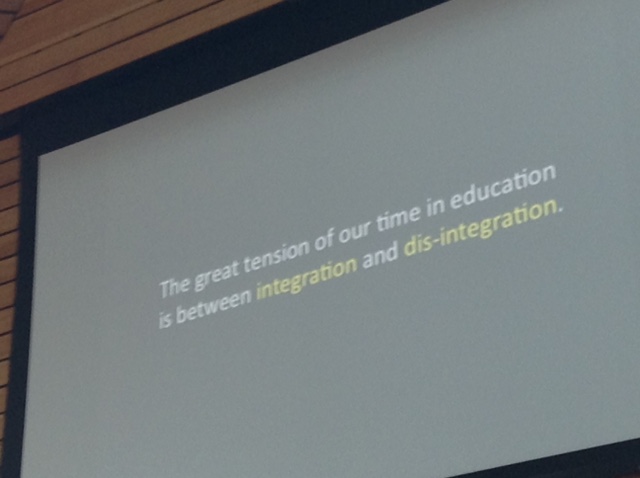
integration and dis-integration
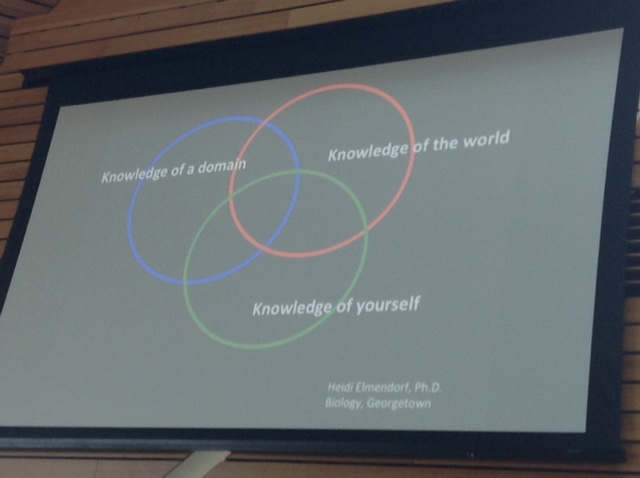
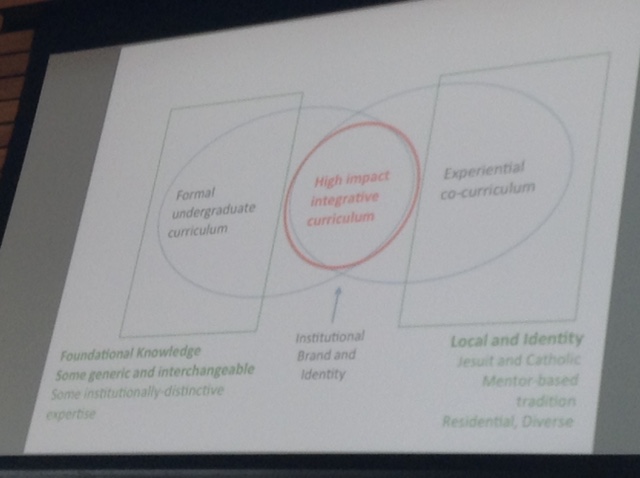
high impact integrative curriculum

what makes high inpact practices high impact
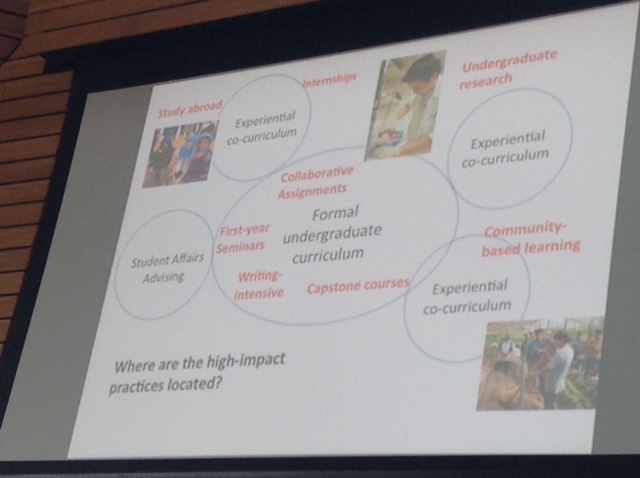
formal versus informal
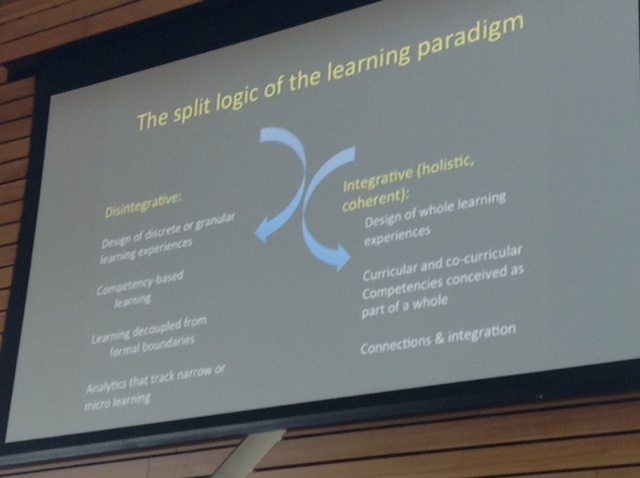
Selected sessions:
The Value of Assessing Outcomes of Teaching Methodologies to guide instructional design
https://guidebook.com/guide/33541/event/10594685/
game-based learning:
Upping your Game – Best Practices in Using Game-Based Learning
https://guidebook.com/guide/33541/event/10594684/
Implementing Game Dynamics in Moodle
https://guidebook.com/guide/33541/event/10693434/
visuals:
Engaging Students through Video Integration
https://guidebook.com/guide/33541/event/10676389/
https://guidebook.com/guide/33541/event/10676375/
Using Flipgrid Video Commentary to Share Student Learning
https://guidebook.com/guide/33541/event/10676361/
————
Enhancing learning with online narrated presentations using VoiceThread
https://guidebook.com/guide/33541/event/10676372/
flipped:
Essential Technology & Tools for Flipping Your Classroom
https://guidebook.com/guide/33541/event/10676385/
Improving Delivery of Technical Course Content through Incremental Use of Classroom “Flipping”
https://guidebook.com/guide/33541/event/10676376/
https://guidebook.com/guide/33541/event/10594850/
The Pros and Cons of Flipping the Classroom
https://guidebook.com/guide/33541/event/10676323/
Using Google Forms for Student Group Evaluations
https://guidebook.com/guide/33541/event/10734863/
Library:
The University Libraries Partnership for Affordable Content – Enhance Student Learning and Save Them Money!
https://guidebook.com/guide/33541/event/10676358/
CRS Tophat:
Using Classroom Debates as an Interactive Learning Tool in a Course on Companion Animal Ethical Issues
https://guidebook.com/guide/33541/event/10676369/
online:
Adapting the Harvard Case Method for Online Courses
https://guidebook.com/guide/33541/event/10595018/
Readiness Assessment for Online Courses
https://guidebook.com/guide/33541/event/10595040/

technology showcase general view
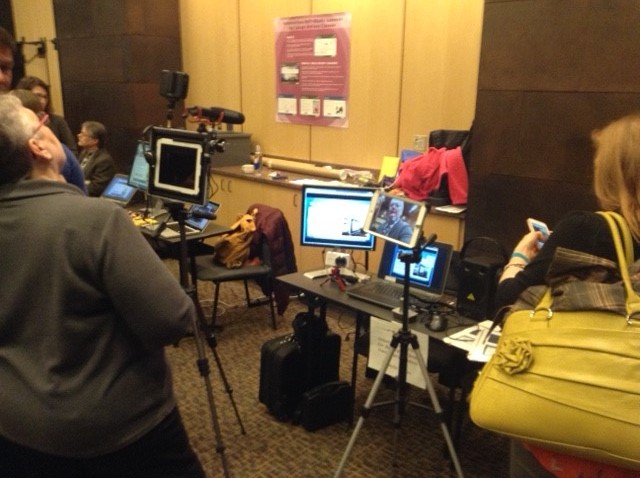
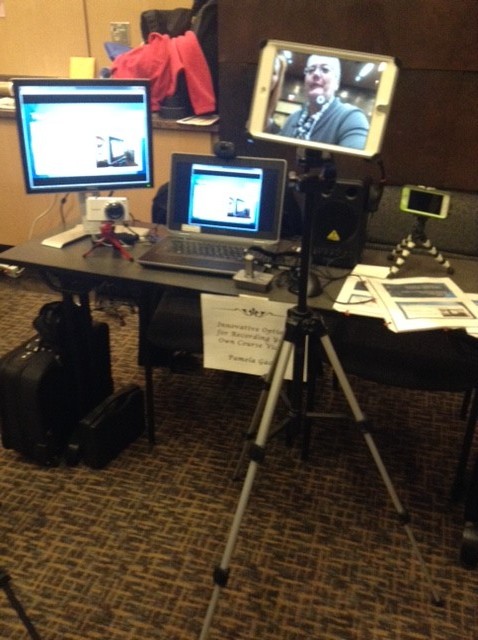
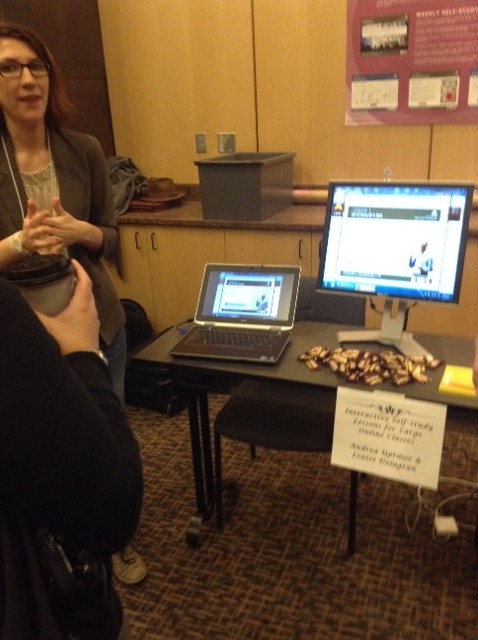


http://www.tandf.co.uk/journals/access/white-paper-social-media.pdf
#tfsocialmedia
Social media objectives:
- promotion
- collection management tool
- Outreach
- teaching and learning
Opportunities and challenges
- opportunity to build a sense of community between the library and its users
- the variability of skills across library staff for using social media effectively, striking the right tone between professional and personal, coordinating activities across the institution to avoid duplication
- maintaining visibility for the library brand and copyright issues relating to hosting library resources on social media sites
Policies and management:
- Librarians are divided on the benefits of introducing formalized social media policies and plans. About a third of libraries responding to the Taylor & Francis survey had a policy in place, but over 40% had no plans to introduce one
- Some believe that representing the library as a professional function with a
consistent tone is the priority, while others believe that a more human approach is important, with individual staff free to bring their own ideas and personalities to social media activities.
Effectiveness and assessment:
- difficult to prove return on effort and that the time required to do this was a major barrier to more comprehensive analysis of impact
- framework for evaluation, so it is likely that assessment against commonly agreed metrics will become an increasingly important part of social media activity within the library in the near future
Current Social Media Practices:
- In a study from the mid 2000s (Cantrell and Havens1 ), most library directors in the US when questioned about social media said they did not think that libraries had a role in social networking
- A more recent study from 2012 (Kai-Wah Chu and Du4) shows how use of social media by the library has now become mainstream. In this survey of libraries in Asia, North America and Europe, 71% were found to be using social media tools with a further 13% saying they planned to use them
Advantages of using social media
n Financially the costs of using social media are perceived to be low;
n It requires little training;
n It promotes library services and disseminates news quickly, delivering this information more directly to library users;
n It increases engagement and interactions with library users;
n It helps gather feedback to enhance user services;
n The promotion of library holdings via social media can help increase usage of content;
n It enhances communication both within the library and with other departments;
n It can be used for outreach activities through onward sharing, well beyond the institution itself, helping build connections and reputation more broadly
Social Media Objectives: graph on page 8 of the PDF document:
A To promote events
B To promote library services
C To promote resources/collections at the library
D To update on library refurbishments
E To promote new acquisitions
F To promote library guides, exhibition guides
G To connect with new students joining the university
H To engage with the academic community
I To connect with the wider community beyond the university e.g. the town in which the institution is based
J To connect with distance learners
K As a customer services tool- complaints, suggestions, enquiries, feedback
L To highlight subject specific information
M To connect with potential students
N As a teaching tool to promote information literacy, technology and writing tips (not library based)
O To promote courses
P As a research tool to locate official documents and studies
From UK-based focus group: “The library is a programme, not just a building.”
Channel preferences: Graph on page 10 of the PDF document
SOCIAL MEDIA USES Table on p 13 of the PDF document
Twitter n Distribute library news and information
n Provide customer service
n Build connections with researchers
n Build connections with other librarians and institutions
Facebook n Distribute library news and information
n More social and less formal than Twitter – share photographs and run competitions
n Arrange events including tracking RSVPs and sending event updates
n Engagement with students
Pinterest n Promote general library collections, digital and archive special collections and information literacy
n Set up of online repositories for students to pin researched references as part of
collaborative group work
n Display book titles to save time browsing and promote new titles
n Provide an arena for students and course leaders to pin reviewed and recommended reading
for a particular topic
n Develop communities with other online libraries
YouTube n Streaming film collections
n Instructional ‘how to’ videos teaching information literacy skills and how to use library
services and resources
There are also a number of other social media products that are being used by librarians that reflect regional
preferences and the need for the specific functions offered by niche applications.
Collection usage and discovery: Graph on p. 15
Teaching and learning
From US-based librarian interview: “The trend in education now is to create environments that foster collaborative learning. Faculty have ditched textbooks and course management systems in exchange for a Facebook page for their class, or a wiki, or a blog. These online environments are fun; students already know how to use them and are more motivated to comment, discuss and share in these environments than a dry CMS.”
Social media policies and management, p. 18
73% of respondents stating that they believed more roles dedicated to social media would appear in the library in the future.
Effectiveness of social media
From UK focus group: “We keep track of something particularly successful, then we redo the campaign 6 months later.”
From US focus group: “We have very few interactions with anyone on our Twitter feed.”
“Twitter is definitely the best platform, because we hashtag all of our posts with the keyword
of the publication, and so for the academic audience, once they click it’s going to pull up all
of the similar publications under that topic.
Promoting library social media channels
From UK focus group:
“We retweet each other to encourage new followers.” My note: Suggested by me regarding SCSU_Library for Twitter and Pinterest and SCSUTechinstruct but “considered” (in local lingo, slow death of the idea)
https://chroniclevitae.com/news/768-teaching-and-the-university-of-tomorrow
MOOC promoters continually claim that their products provide technologies that have never appeared in face-to-face classrooms. While I don’t disagree that my courses have lacked fun ways to draw molecules (because I teach in the humanities), I do find their insistence that traditional higher ed lacks technological advances to be odd. If you took the MOOC prophets seriously, it would seem that all real-time professors do is lecture to bored students. – See more at: https://chroniclevitae.com/news/768-teaching-and-the-university-of-tomorrow#sthash.RuCJxbAU.dpuf
What I believe Kelly Backer [intentionally?] misses to say is that MOOC claims to be progressive, meaning “a new mode/model” of teaching, but it relays on the old (from medieval times) values: the attempt to put “skin in the game” or pay for certificates, fails, since, according to Backer, the employers don’t care about those certificates. It is not sufficient to “move” the teaching process in the “future,” if the evaluation process remains in the medieval terms.
https://www.insidehighered.com/news/2014/10/01/survey-shows-training-and-support-remain-top-issues-among-it-officials
college and universities are unable to offer the right training to faculty, staff and students. IT officials’ evaluations of their own institutions’ IT infrastructure present almost a mirror image of their list of priorities. While 81.4 percent of respondents listed faculty development as their top priority, only 27.9 percent rated their existing training offerings as excellent (or a seven on a seven-point scale). At 12.8 percent, IT training for students drew the second-lowest share of respondents giving it an excellent rating.
http://podnetwork.org/event/pod-2013/
Conference program available in PDF and upub format, so I can have it on my laptop and on my mobile device: diminishes the necessity to carry and pull constantly a paper stack.
it is the only conference I know with 6AM yoga. Strong spirit in a strong body. LRS & CETL must find space and instructors an offer mediation + yoga opportunity for SCSU students to disconnect
1:00 – 5:00 PM excursion to Carnegie Mellon – Learning Spaces. LRS interest in Learning Commons.
From the pre-conference workshops, Thurs, Nov 7, 8:30AM – 12:00PM:
Linda Shadiow, Connecting Reflection and Growth: Engaging Faculty Stories.
This workshop seems attractive to me, since it coincides with my firm conviction that SCSU faculty must share “best practices” as part of the effort to engage them into learning new technologies.
Kenyon, Kimberly et al, Risky Business: Strategic Planning and Your Center.
This workshop might be attractive for Lalita and Mark Vargas, since strategic planning is considered right now at LRS and CETL might also benefit from such ideas.
roundtables, Thurs, Nov. 7, 1:30-2:45PM
Measuring the Promise in Learner-Centered Syllabi
Michael Palmer, Laura Alexander, Dorothe Bach, and Adriana Streifer, University of Virginia
Effective Faculty Practices: Student-Centered Pedagogy and Learning Outcomes
Laura Palucki Blake, UCLA
Laura is the assistant director http://gseis.ucla.edu/people/paluckiblake
3 time survey of freshmen. survey also faculty every 3 years. can link this date: faculty practices and student learning
triangulating research findings. student-centered pedagogy. which teaching practices are effective in promoting student-center learning practices.
no statistical differences in terms of student learning outcomes between part-time and full-time faculty. The literature says otherwise, but Laura did not find any statistical difference.
http://ow.ly/i/3EL77
discussions is big, small group work is big with faculty
in terms of discussions, there is huge difference between doing discussion and doing it well.
this is a self-report data, so it can be biased
there are gender differences. women more likely to use class discussions, cooperative learning same, students presentations same. gender discipline holds the gender differences. same also in STEM fields.
students evaluations of each other work. cooperative learning: it is closer gender-wise.
the more student-centered pedagogy, the less disengagement from school work.
understand on a national level what students are exposed to.
lpblake@hmc.edu
http://www.heri.ucla.edu/
wabash national data.
ePublishing: Emerging Scholarship and the Changing Role of CTLs
Laura Cruz, Andrew Adams, and Robert Crow, Western Carolina University
LORs are in Kentucky.
CETL does at least Professional Development, Resources, Eportfolios, LORSs. FLCs
Teaching Times at Penn.
model 2: around instructional technology. More and more CETL into a combined comprehensive center. about 9 are paid by IT and 11 by academic center. because of finances cuts this is the model predicted from the 90s. Why not IT? because ater they say how to use it. and how to use it effective. think outside of technology, technogogy is not the same as technology. Teacher-scholar model: research, service, teaching.
http://ow.ly/i/3EMJl
egallery and other electronic ways to recognize productivity. Stats and survey software does NOT reside with grad studies, but with CETL, so CETL can help faculty from a glimmer of an idea to presentation and publication. Research Support Specialist.
how and where it fits into faculty development. Neutrality. Should CETL be advocates for institutional, organizational change. Do CETL encourage faculty to take innovation and risk (change the culture of higher ed). Tenure and promotion: do we advocate that epub should count, e.g. a blog will count toward tenure.
a national publication: http://www.sparc.arl.org/resources/authors/addendum
we domenstrate that it is good school. scholarship of teaching will be good teaching.
OER? Open educational resources. SHould CETL host and participate in those? Do we participate in creating resources, which are designed to replace texbooks? Caroline has a state-wide grant to support faculty developing learning resources.
open access is controversial. the right to publish and republish. http://www.sparc.arl.org/
40% of all scholarly articles are owned by 3 publishers
Academic Social Media academic.edu and electronic journals.
CETL is the comprehensive center, the hub where people go to, so CETL can direct them to and or get together stakeholder to make things happen.
the lesson from this session for me is that Lalita and Keith Ewing must work much closer.
Evaluating the quality of MOOCs: Is there room for improvement?
Erping Zhu, University of Michigan; Danilo Baylen, University of West Georgia
reflection on “taking” a MOOC and the seven principles. how to design and teach MOOC using the seven principles.
MOOC has a lot of issues; this is not the focus, focus is on the instructional design. Both presenters are instructional designers. Danilo is taking MOOC in library and information science.
Second principle: what is a good graduate education.
about half had completed a course. Atter the 3rd week the motivation is dissipating.
Erping’s experience: Provost makes quick decision. The CETL was charged with MOOC at U of Michigan. Securing Digital Democracy. http://www.mooc-list.com/university-entity/university-michigan
Danilo is a librarian. his MOOC class had a blog, gets a certificate at the end. Different from online class is the badges system to get you involved in the courses. the MOOC instructors also had involved grad students to monitor the others. the production team is not usually as transparent as at Corsera. Sustainability. 10 week module, need to do reflections, feedback from peers. 7 assignments are too much for a full-time professional.
http://www.amazon.com/Library-2-0-Guide-Participatory-Service/dp/1573872970
http://tametheweb.com/category/hyperlibmooc/
http://tametheweb.com/2013/10/20/hyperlibmooc-library-2-013-presentation-links/
1. principle: contact btw faculty and student. Not in a MOOC. video is the only source provides sense of connection. the casual comments the instructor makes addressing the students provides this sense. Quick response. Collaboration and cooperation in MOOC environment and bring it in a F2F and campus teaching. Feedback for quizzes was not helpful to improve, since it i automated. students at the discussion board were the one who helped. from an instructional design point of view, how MOOC design can be improved.
group exercise, we were split in groups and rotated sheet among each other to log in response to 7 sheets of paper. then each group had to choose the best of the logged responses. the responses will be on the POD site.
eri week resources
Per Keith’s request
“Why Students Avoid Risking Engagement with Innovative Instructional Methods
Donna Ellis, University of Waterloo”
Excerpt From: Professional and Organizational Development Network in Higher Education. “POD Network 2013 Conference Program, Pittsburgh PA 11/7 to 11/10.” iBooks.
This material may be protected by copyright.
A quantitative study. The difficulty of group works. Various questions from the audience, the time of class (early Mrng) is it a reason to increase the students disengagement. Students pereceptions .
The teacher did. It explain why the research and this might have increased the negative perception. Summary of key barrierS.
Risk of negative consequneces
preceived lack of control
contravention of perceived norms.
fishbein and Aizen 2010
discussoon . How faculty can design and deliver the course to minimize the barriers. Our table thought that there are a lot of unknown parameters to decide and it is good to hear the instructor nit only the researcher. How to deal with dysfunctional group members behaviors. Reflections from the faculty member how to response to the data? Some of the barriers frustrated him. Outlines for the assignments only part of the things he had done to mitigate. What are we asking students on course evaluations. Since a lot more then only negative feedback. Instructor needes more training in conflict resolution and how to run group work.
http://ow.ly/i/3Fjqt
http://ow.ly/i/3Fjpq
CRLT Players
Friday, Nov 8, 10:30 AM – 12:00 PM
William Penn Ballroom
7 into 15
CRLT Players, University of Michigan”
Excerpt From: Professional and Organizational Development Network in Higher Education. “POD Network 2013 Conference Program, Pittsburgh PA 11/7 to 11/10.” iBooks.
This material may be protected by copyright.
It is a burlesque and theater approach to engage students and faculty into a conversation. 10 plays in 30 min.
Discuses different topics from the plays and seek solutions as a team. How to deal with international students ( Harvard lady said ” safe places” for students) how to deal with technology or the lack of it, missed next one writing this notes and how to reward faculty in innvative things. T. Encoruage innovation, they received a letter from the provost and if they fail, it is not used in their annual evaluation
No videotaping of this performance because the power is in conversation. Is there a franchise, like training people to do that. NSF grant was allowing them but now just pick up the idea. Sell scripts? Can have conversations about strategies how to collaborate with the theater department where to start these short vinniets. If come to campus and bring performance do they do also the follow up.
Is anger or hostility a reaction during after these presentations. How to handle it. Hostility can be productive and make sure that it is told that it is productive. Getting difficult things out there is what the theater is trying to do in a distant way. This is not a morality
how develop the work? How come up with issues. Faculty bring issues, followed by interviews, draft created we heater identifies the problem and address the issue. Preview performances with stakeholders who confirm . There are more then. Sufficient ideas, so the organizers can choose what they see most pertinent
ecrc committee went to their meeting instead of lunch to see if I can particpirate for next year activitities. Ecrc is the acronym for the tech committee. Web site is one takes of this committee. Word press site , how the groups work, how forms work, how to connect with people and most importantly how to start communicating through the web site and cut the listserv. An attempt to centralized all info in the website rather then scattered across universities.
what is BRL? Google apps and Wikipedia as a wiki for another year until figure out if it can be incorporated in the web site. Reconceptualize how do work in the process. To groups in ecrc. Wikpaidea and web page. And then social media with Amy? Ecrc liaison in every POD committee to understand how to set up the committee web presence. Blackboard collaborate to do meetings and this is what liason explain to committee members. Tinyurl.com/ECRC2013
Designing Online Discussions For Student Engagement And Deep Learning
Friday, Nov 8, 2:15 PM – 3:30 PM, Roundtable
Parkview East
Danilo M Baylen, University of West Georgia”
pit must be asynchronous discussion
What is the purpose and format of the discussion. Assessment. How the online discussion is supporting the purpose of the curriculum to the students learning
About five discussions per semester all together. Behaved part of the class culture
Format of the assignment
asynchronous discussion list. Series of questions or a case study. Is the format a sequence of responses or invite a discussions
checklist which stifles a creative discussion or just let it more free
purpose – must be part of the syllabus and it must be clear.
Meeting learning objectives.
duration
interactivity – response to other students. List of 6 different options how they can reply. what format the interactivity takes Is important issue, which has no textbook
assessment- initial posting are critical, since it gives and idea what to work on. How much points as part of the bigger picture. Yet it is the ground work for the assignment, which gets most points.
metacognitive not evaluative , give students examples from the pro regions class what a good discussion is And explain students how to. Evaluate a good discussion entry
how the question is worded and use the threaded discussion for them to reflect how they think, rather then only assess if they read the chapter. The research about online discussion is very different.
What is the baseline.
Online course must must be set up ready before semester starts or not?
reflection for the end of the semester
SteVn brookfields critical questionaire
meet thISTI and qr standards
is reflection on the content or the process
students reflect on their own reflections
what have you learned about yourself as online learner and look for consistencies for both negative and positive reflections
Assess critical thinking
there is a workshop by the presenters instituitions how to organize
more claims then actual evidence so Data is sought to
main issues
programmatic emportfolio. Not student presentation portfolios, but academic portfolio
e portfolio forum
look at image of the green copy:
1. Integration and reflection
2. Social media – in community with other students , faculty, organizations
3. Resume builder
eportfolio is. Prt of the assessment. Conversation on campus. Some depts use exportfolio extensively but not happy. Programmatic academic e portfolio to collect data
use Sakai open portfolio system
12 drepartments and six more second year. to speak the same language, they developed a guideline, conceptual framework ( see snapshot of handout)
Curriculum mapping ( see the grid on the. Handout) took much longer then expected.
the role of CETL. The provost at Kevin’s institution charged CETL to do the portfolio gig.
The big argument of the CETL redirector with the provost is that portfolio not only to collect data for assessment and accreditation but to provide meaningful experience for the students. EDUCAUSE report horizon, learning analytics Scandalous headlines of students suing law schools. bad deductions made on big data. The things that matte for students must be in the portfolio and they get used to use the portfolio. Pre reflection entries by the students, which shorted the advising sessions. The advisor can see ahead of time. The advisers. Will. B the. Focus point, The. Advising portfolio Is becoming
portfolio must be used by faculty not only students.
Whats the by in for students. Presentations portfolio part of. Marketing purposes. Google sites so when students leave the institutions students can ” take” the portfolio with them as we’ll go multimedia. attempts failed because platforms which can be cutozmized we’re not used Digital identity As CETL director not technology expect and how to learn from the faculty and that was very
documenting and learning with eportfolios.
faculty to demonstrate reflections to students and how enter into portfolio. Using rubrics. Faculty are using already tools but connecting with. Reflections.
STAR: Situation , tasks, action, response
Writing skills differentiate, but even good writers got better on reflection
how one polish a portfolio before bringing to an Employer. Student Working with career services to polish and proofread.
How much the university is responsible for an individual portfolio. How many levels of proof reading.
Poor student work reflects a poor faculty attention.
Lorna Kearns, University of Pittsburgh”
Freedom to Breathe: A Discussion about Prioritizing Your Center’s Work
Andy Goodman and Susan Shadle, Boise State University
Connecting, Risking, and Learning: A Panel Conversation about Social Media
Michelle Rodems, University of Louisville. Conference C 9:00 AM – 10:15 AM
The use of social media in higher education
Conference C 9-11:15 AM
Panel of CETL directors and faculty. The guy from Notre dame uses word press the same way I use it. Collect questions and after the 3rd one creates blog entry and answers the next q/ s with the URL to the blog entry NspireD is the name of. The blog
the OHIO state UCAT guy is a twitter guy. Program coordinator who manages wordpress and web site. Intersect with FB and twitter. Platforms are inteGrated, so be did not to know the technicalities. The graduate consultants are setting up. ciirdinator tried to understand how the mesh together. Can be used as conversation starters or to broadcast and share info. Use of hashtags how to use them appropriate in twitter and FB to streamline .
Scsu problem. W don’t build it they will not come. a Tim burton version of the field of dreams.
Rachel CETL assist dir at U of Michigan. She is out there personally likes it. Very static web page. Drupal as a content management system so the blog is part of the web page. So 2 times a week entries. One of the staff people is an editor and writes blog posts, but vetted by a second CETL staff. Auto push for the blog to the twitter. Screencasts for YouTube channel with screencasts. Comments on the blog minimal from faculty and stat. What about students? About 1000 followers on the twitter. What do analytics say. Hits on home page, but no idea how much time reading. The time people spend more time and using the tags . the use of blog is less formal way to share information. recycling in December and August a lot of material.
does anybody subscribe and do you promote RSS
the separate blog for a workshop requires interaction and that is a success
for faculty development U of Michigan is using blog recruited 50 to follow the blog. TSam of 3 using. WordPress For a semester and then survey. Focus group. Huge success, between 6 and 30 comments. Community with no other space on campus
how are u using social media to promote connections. elevate voices of others on campus by interviewing faculty. At U of Michigan there was no interest to learn about what other faculty are doing. So they trashed that initiative but starTed a video narration about faculty who innovate. Videotaped and edited no hi Qual video , tagged and blog posted and this approach created more connection, because it is not text only.
What have been the obstacles and indoor failure and what have you learned?
convincing the administration that CETL than do it and it does not have to be the same quality as the web page and the printed material. Changing the mindset. No assessment, since nothing else was working and they were ready for radical step such as blog
Same with the twitter. Taking the risk to experiment with the hashtags. Tweets can’t be approved. Need to time to build an audience, one month will not have an impact. Start with the. Notion that you are building a reposIvory noT a foRum
one of the panelist has a google spreadsheet which has information of allCETL social media sites There are resources on how to deal with negative outcomes of using social media. Working with librarians, the Norte dame said! they will give you twenty sources. No no, no, he siad, give me your best three.
U of MichiGan more grad studns blog guest posts almost no faculty.
Have you considered giving them more then guest blog, but no facilitator? Let faculty once a semester do a blog post. It is not moderated but more like lead to how to do a good blog. Interview based approach is unique and does not show up somewhere elSe.
Insitutional background important in these decisions.
How often refresh the wordpress page. How often one person is voicing and it takes a log of journalistic skills. Use the draft option to publish when there are several ideas coming at once.
Mindshift of CETL is to decrease the standards. Make it more informal. Blog post can be always fixed later. To avoid faculty false perception that this is not scholarly needs to be references. So causal tone + references.
Blog ” from students perspective” is repurposE
Risking Together: Cultivating Connection and Learning for Faculty Teaching Online
Michaella Thornton, Christopher Grabau, and Jerod Quinn, Saint Louis University
Oliver 9-11:15 AM
Space Matters! and Is There a Simple Formula to Understand and Improve Student Motivation
Kathleen Kane and Leslie A. Lopez, University of Hawaii at Manoa
Riverboat 9:00 AM – 10:15 AM
The Risks and Rewards of Becoming a Campus Change Agent
Dr. Adrianna Kezar, University of Southern California
William Penn Ballroom 10:30 AM – 12:00 PM
Branch campuses, students abroad, to more with less, completion from profit institutions
students work more but this is a good reflection on learning success
provost might ask to consolidate prof development opportunities for faculty and students instead of faculty only.
If administration is genuine understand transparent Administration more about persuading not listening. Respect, not assuming that faculty will not accept it. If faculty will sacrifices what will faculty see the administration sacrifice on their side. Leading from the. Middle , it means collective vision for the future. Multilevel leadershup, top down efforts dont work and bottom top are fragile. Managing up is less preferred then powering up. It is difficult to tell administration that they miss or misunderstand the technology issue.
Four frames. Goal multi frame leadership http://www.tnellen.com/ted/tc/bolman.html. Vey much the same as Jim Collins good to great right people on the bus right trained http://www.afa1976.org/Portals/0/documents/Essentials/Creating%20Organizational%20Learning%20and%20Change.pdf
How to build coalition, different perspectives, aknowledge the inherent conflict.
The Delphi project
It Takes a Campus: Promoting Information Literacy through Collaboration
Karla Fribley and Karen St. Clair, Emerson College
Oakmont 1:45 PM – 3:00 PM
Most of the attendees and both presenters were librarians
The presenters played a scatch to involve the particppaints
deifnition what is IL. https://mobile.twitter.com/search/?q=%23POD13&s=hash
http://ow.ly/i/3G00e/original
Information literacy collaborative work with faculty to design student learning outocmes for information literacy
Guiding principles by backward course design
Where they see students struggle with research
question to students survey, what is most difficult for your and wordle.
http://ow.ly/i/3G0l6/original
self reflection ow.ly/i/3G0UH
Curriculum mapping to identify which courses are the stretigic ones to instill the non credit info litreacy
acrl assessment in action
Risky Business: Supporting Institutional Data Gathering in Faculty Development Centers
Meghan Burke and Tom Pusateri, Kennesaw State University
Oliver 1:45 PM – 3:00 PM Roundtable
Exploring Issues of Perceptual Bias and International Faculty
Shivanthi Anandan, Drexel University.
Heinz 3:15 PM – 4:30 PM Roundtable
Why do we need it and onoy regarding international faculty don’t in Kim Lisa wolf-wendel
susan twombly. Pointers for hiring and retention. Performance is both teaching and living. Sanitary effect. sanitary issues not only pay rate. FLC all tenure track without citizenship they are worried about their tenure. Funding agencies, very few will fund you if you are not a citizenship
Diane Schafer perceptual biases, graffiti. Cathryn Ross
Averting Death by PowerPoint! From Killer Professors to Killer Presenters
Christy Price, Dalton State College
Riverboat 4:45 PM – 6:00 PM
How to create effective mini lectures checklist for acting palnning
engage and leave lecture out. The reason why can’t move away is because some people lecture as performance art
Make lectures mini. How long mini should be. 22 min, the age number of the person.
Emotional appeal, empathy.
Evoke positive emotions with humor. Always mixed method research, since the narrative Berk, r. (2000) and Sousa (2011)
ethical. Obligations and emotional appeal
acknowledge the opposition
enhance memory processing with visuals and multimedia
use guided practice by miniki zing note taking
presentationzen is a book! which need to read http://www.barnesandnoble.com/w/presentation-zen-garr-reynolds/1100391495?ean=9780321525659
Enchanted memory processing by creating mistery
address relevance
http://advanceyourslides.com/2011/01/28/the-5-most-memorable-concepts-from-nancy-duartes-new-book-resonate/
Death by PowerPoint: Nancy Duarte: The secret structure of great talks
http://www.ted.com/talks/nancy_duarte_the_secret_structure_of_great_talks.html
http://www.gobookee.org/get_book.php?u=aHR0cDovL3d3dy5vcGVuaXNibi5jb20vZG93bmxvYWQvMDQ3MDYzMjAxMS5wZGYKVGl0bGU6IFJlc29uYXRlOiBQcmVzZW50IFZpc3VhbCBTdG9yaWVzIFRoYXQgVHJhbnNmb3JtIC4uLg==
Engage faculty by showing. Faculty how their presentation. Is. And how it c can be
process with clickers
Sunday Mrng session
vygotsky zone of NAND the flipped mindset. http://t.co/vCI8TOJ7J2. Cool tweets at #pod13.
Ideas process baudler Boyd stromle 2013
I – identify the issue
D debrief the situation
A analyze what happened
s strategize solutions and Oport unities for growth and future success
list of peer reviewed literature on “flipped classroom”
Findlay-Thompson, S., & Mombourquette, P. (2013). EVALUATION OF A FLIPPED CLASSROOM IN AN UNDERGRADUATE BUSINESS COURSE. Global Conference On Business & Finance Proceedings, 8(2), 138-145.
http://search.ebscohost.com/login.aspx?direct=true&AuthType=ip&db=buh&AN=89496806
Davies, R., Dean, D., & Ball, N. (2013). Flipping the classroom and instructional technology integration in a college-level information systems spreadsheet course. Educational Technology http://search.ebscohost.com/login.aspx?direct=true&AuthType=ip&db=keh&AN=88785048
Davies, R., Dean, D., & Ball, N. (2013). Flipping the classroom and instructional technology integration in a college-level information systems spreadsheet course. Educational Technology Research & Development, 61(4), 563-580. doi:10.1007/s11423-013-9305-6
http://search.ebscohost.com/login.aspx?direct=true&AuthType=ip&db=keh&AN=88785048
Missildine, K., Fountain, R., Summers, L., & Gosselin, K. (2013). Flipping the Classroom to Improve Student Performance and Satisfaction. Journal Of Nursing Education, 52(10), 597-599. doi:10.3928/01484834-20130919-03
http://search.ebscohost.com/login.aspx?direct=true&AuthType=ip&db=rzh&AN=2012318677
Butt, A. (2014). STUDENT VIEWS ON THE USE OF A FLIPPED CLASSROOM APPROACH: EVIDENCE FROM AUSTRALIA. Business Education & Accreditation, 6(1), 33-43.
http://search.ebscohost.com/login.aspx?direct=true&AuthType=ip&db=buh&AN=90567007
Strayer, J. F. (2012). How Learning in an Inverted Classroom Influences Cooperation, Innovation and Task Orientation. Learning Environments Research, 15(2), 171-193.
http://search.ebscohost.com/login.aspx?direct=true&AuthType=ip&db=eric&AN=EJ977852
Critz, C. M., & Knight, D. (2013). Using the Flipped Classroom in Graduate Nursing Education. Nurse Educator, 38(5), 210-213. doi:10.1097/NNE.0b013e3182a0e56a
http://search.ebscohost.com/login.aspx?direct=true&AuthType=ip&db=rzh&AN=2012296027
Herreid, C., & Schiller, N. A. (2013). Case Studies and the Flipped Classroom. Journal Of College Science Teaching, 42(5), 62-66.
http://search.ebscohost.com/login.aspx?direct=true&AuthType=ip&db=keh&AN=86988365
Jottings by Saquarrah. (2013). Medical Teacher, 35(6), 532-533.
http://search.ebscohost.com/login.aspx?direct=true&AuthType=ip&db=aph&AN=89131643
search.ebscohost.com/login.aspx?direct=true&AuthType=ip&db=tfh&AN=85672747
Brunsell, E., & Horejsi, M. (2013). Science 2.0. Science Teacher, 80(2), 8.
http://search.ebscohost.com/login.aspx?direct=true&AuthType=ip&db=sch&AN=85127911
You are invited to participate in the “First Annual SCSU Technology in Teaching and Learning Summer Institute” co-sponsored by the Center for Continuing Studies, InfoMedia Services and the Center for Excellence in Teaching and Learning.
When? Monday, May 13 – Tuesday, May 14, 2013
Where? Miller Center
Space is limited to 75 participants. Registration is required and can be completed at this link: http://www.eventbrite.com/org/3606333855
The Institute program is available here: http://web.stcloudstate.edu/informedia/cetl/tech_institute_schedule.docx
Participants are eligible for incentive awards to support their teaching with technology. Please see the attachment, “participant incentives.”
The goal of the SCSU Technology in Teaching and Learning Summer Institute and its follow-up sessions is to provide high quality and effective pedagogical strategies, skills and discussions around the use of technology for teaching and learning in online, face-to-face and blended courses. This Institute is part of our on-going varied and collaborative efforts to foster a professional peer learning climate around teaching and learning with technology.
Participants who attend all sessions on both days including the follow-ups and complete all evaluations will have the opportunity to use their self-assessment of current skills and knowledge of technology and select sessions in order to:
• Acquire basic and advanced skills in using the current Learning Management System, i.e. D2L
• Distinguish the appropriate use of pedagogical strategies with technology in online, face-to-face and blended settings
• Explore opportunities to improve student learning through application of e-conferencing tools (e.g. Adobe Connect), and Web 2.0 tools such as social media, etc.
• Meet and interact with faculty and staff experts and mentors and learn the processes by which they can get additional and on-going support for each of the above areas.
Please register no later than Wednesday May 8.
“Full-time faculty and full-time professional staff with teaching responsibilities who participate in both days of the “Summer Institute” and complete the evaluations will be rewarded with a $300 coupon for a one-time purchase of material that directly supports teaching with technology at the SCSU Computer Store in the Miller Center. Faculty who participate in one of the two days will receive a $150 coupon for the same purpose. Coupons are not transferable.
Please remember that the items purchased remain the property of SCSU but may be used by the purchaser to support their teaching and related academic activities.
Upon completion of the “Summer Institute” participants will be contacted by the SCSU Online Office to verify level of participation in the institute and verify eligibility for funds. These funds must be spent by June 15, 2013.”
Clarification on Presenters Registration
- Presenters do not have to register unless they want to attend both days.
- If presenters are not going to participate in sessions other than the one(s) they are presenting but want to eat lunch with us on either day please contact me directly so we can add you to the lunch count and identify any dietary needs
















